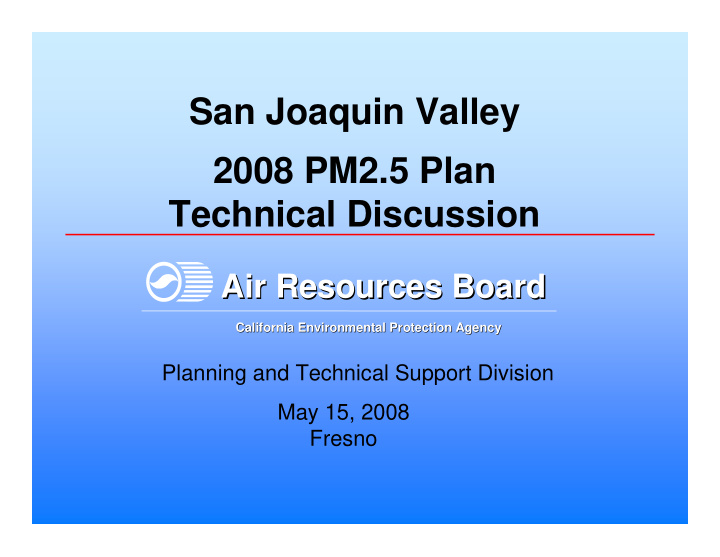



San Joaquin Valley 2008 PM2.5 Plan Technical Discussion Air Resources Board Air Resources Board California Environmental Protection Agency California Environmental Protection Agency Planning and Technical Support Division May 15, 2008 Fresno
CRPAQS Provides Scientific Basis • Extensive field monitoring at the surface and aloft – hundreds of monitoring sites – millions of data records – numerous teams of experts • Improved emission inventory • State-of-the-science air quality modeling • World class data base 2
CRPAQS Findings Nature of PM2.5 Problem • PM2.5 highest in winter • Ammonium nitrate and organic carbon are major components: • Ammonium nitrate throughout Valley • Organic carbon highest in urban areas Key Pollutants to Control • NOx most effective in reducing ammonium nitrate • PM2.5 from combustion sources most effective in reducing organic carbon 3
PM2.5 Air Quality 2004 - 2006 2004-2006 Average Composition Bakersfield Design Values Elements Geological 2% 6% Elemental Carbon • Stockton 5% Ammonium 12.9 ug/m3 Nitrate 39% • Fresno Organic 17.2 ug/m3 Carbon 35% • Bakersfield Ammonium 18.9 ug/m3 Sulfate 13% 4
Emission Inventory • Comprehensive review of all emission categories. Incorporated updates to: – Agricultural Burning – Residential Wood Combustion – Cooking – Manufacturing and Industrial Fuel Combustion – Fugitive dust • Prepare spatially and temporally distributed emission inventories for air quality modeling 5
Attainment Demonstration • Attainment demonstration characterizes the emission reductions needed for attainment • U.S. EPA requires weight-of-evidence approach for attainment demonstration • Multiple tools used: – Air quality and emissions trends – Source apportionment and other modeling (rollback) – Grid-based photochemical modeling 6
Air Quality Modeling • Models Used: – Air Quality – CMAQ (U.S. EPA Community Multi-Scale Air Quality Model) – Meteorology – MM5 (Pennsylvania State University / National Center for Atmospheric Research Mesoscale Model) • Periods Modeled: – One full year of daily modeling – 2000 used to establish model performance (CRPAQS) – 2005 and 2014 used to evaluate attainment (with 2000 meteorology) • CMAQ and MM5 models are widely used and thoroughly peer-reviewed • Conducted according to U.S. EPA guidelines • Run on multiple computer clusters 7
Control Strategy PM2.5 Controls 23 tpd New • Already adopted controls District Measures Adopted provide most NOx and 30% Controls 48% PM2.5 reductions New State Measures 22% • Full attainment reached with: New NOx Controls District Measures 291 tpd – ARB 2007 State Strategy 3% New State Measures – New District controls 26% Adopted Controls 71% 8
Recommend
More recommend